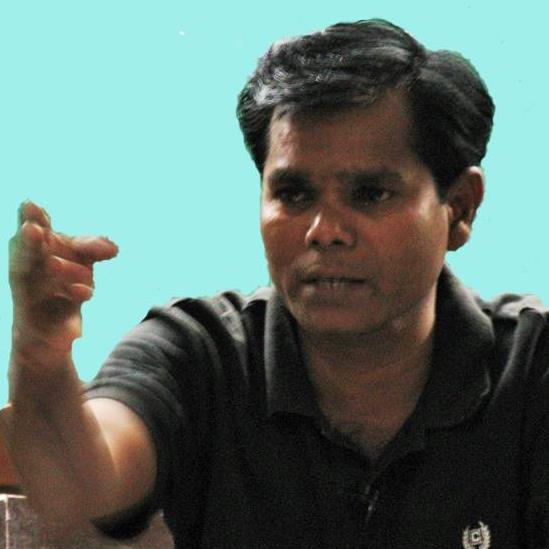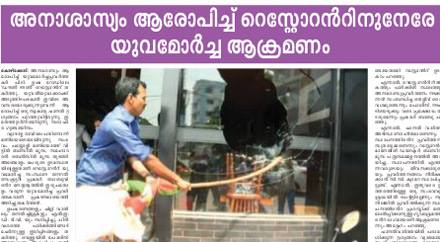Mukesh Kumar
Past and Present: Inherent Contradictions in Psycho-Historical-Political Philosophy in India
 History repeats itself, first as tragedy, second as farce
History repeats itself, first as tragedy, second as farce
~ Karl Marx (2008 :15)
In Indian political history, very few people have achieved such huge success in such a short span of time as prime minister Modi. It would be the height of intellectual laziness to simply brand him a mascot of fascist forces, Hindutva brigade, and nationalistic mindset. More than his pro-development stance, his image is tainted by many controversies. How an image marred with serious accusations finds easy acceptance in the public psyche is the main theme of this paper. Specifically, what role do historical characters and dominating narratives around them play in building a legitimate perception around such public figures? There are deeply entrenched characters in our history and society that help and legitimise the rise of a public figure into an invincible political mammoth psychologically.
The rise of Narendra Modi is the rise of a public spirit historically represented through characters like King Asoka, Maharana Pratap, and Mahatma Gandhi and their perceptions in our mindset. These characters reflect the huge oxymoronic hypocritical nature of mainstream Indian perspective. After killing one hundred thousand people at Kalinga war Asoka preached non-violence afterwards, Maharana Pratap never won a war against emperor Akbar yet remains victorious in our mind than ever before, and Gandhi was Mahatma to the extent that untouchability allegedly miraculously ended in upper caste hearts.
Historical figures like Asoka, Maharana Pratap, Mahatma Gandhi and their representation in history best symbolise historical processes in the form of “event, memory, and metaphor” respectively. Historical facts and events are not merely a neutral source of information, but are deeply entrenched in contemporary politics that reshape use of historical knowledge in popular memories. In line with discussing Modi’s contemporary psychological imaginary, let’s analyse acceptance of his public personality based on three historical figures, Asoka, Maharana Pratap, and Gandhi in our psychic imagination.
There are striking parallels between all these figures including Modi: First; they all represent different historical times: ancient, medieval, modern, and contemporary, second; none of them is Muslim and therefore carry with themselves a majoritarian viewpoint (Asoka in a different sense, though), third; they all collectively help to understand meanings of the binary of state domination (Asoka and Modi) and subjugation (Maharana and Gandhi) in different forms and time, fourth; question of ethics revolves supremely around their lives.
Politics of Higher Ideals
To start with Asoka, he is often designated as a great ancient king who tirelessly worked towards the goal of a non-violent society influenced by the ideals of incipient Buddhism. Should his sermons for non-violence after becoming hegemonic ruler neutralise his act of killing one hundred thousand people (numbers are uncertain, going by textbook references) in the moral imagination of society? As a head of the state, the Kalinga killing is associated with the name of Asoka even if he did not kill all those people by his own hands. In the moral imagination of society, Asoka is a great king since he preached non-violence as an essential state doctrine and less remembered for the unfortunate Kalinga event. Much can be said about his politics of Buddhism and non-violence, but here I am more concerned with morality of our imagination.
Similarly, Narendra Modi, as the then Chief Minister of Gujarat state, is held responsible or at least accused for his role in massacres in 2002 Gujarat riots. The Kalinga killings and Gujrat riots killings slip secretly from our moral imagination and public perception presently at the cost of goodwill images. Firstly, the events of Asoka’s reign are so distant in time that it does not appeal emotionally to us but his popular imaginary in psyche maintains him as a non-violent figure despite being responsible for mass killings. Battles, wars, killings, and destructions have been attributed as ingrained part of non-modern state formations, therefore, as imagination goes, the rulers of the past should, in a way, be kept free from being judged on these parameters. But, the historical representations of such figures: warriors yet benevolent, kind hearted but tough internally – somehow gives sympathy to modern day politicians in our heart.
Like king Asoka in the past, PM Modi should not be criticised for Gujarat violence in the name of greater good, i.e. serving the nation. No matter how Asoka (Modi) behaved as a ruler, now, they represent values of higher significance, therefore, all wrong happenings (doings) are insignificant. Thus, both Asoka and Modi were great rulers in different contexts, argues my historical instinct for public imagination of upcoming millennia in India. Therefore, events do not matter but perception does.
Politics of Commemoration
The second historical figure in this paper, Maharana Pratap is best remembered for his defiance against Mughal emperor Akbar who is often credited with secular credentials for his state policies. The contemporary image of Maharana Pratap is of a Hindu warrior who fought against a Muslim ruler. Again, in the public imagination, sectarian Maharana Pratap fights secular Akbar to uphold the glory of the Hindu nation. Of course, in this projection, Akbar’s Muslim identity is targeted through Maharana Pratap’s Hindu imaginary. Therefore, that the strife between secular and sectarian is an old one, is assumed as popular narrative. And, in this strife Hindus have suffered at the hands of not only Muslim sectarian rulers but by secular Akbar too.
Modi by this logic represents sectarian Hindus who are fighting for the glory of the Hindu nation once again against secular-liberal politicians who are safeguarding enemy Muslim interests. On this note, it’s worth mentioning that Indian secularism does not promote a separation between religion and state like Western secularism does, rather it advocates promoting all religions equally or maintaining equidistance from all religions in state policies. A step further, Indian secularism has projected itself as containing sympathetic and liberal attitude towards Muslims. Thus, secular-liberal leaders are Muslim supporters/sympathisers in sectarian Hindu logic. PM Modi as a tough Hindu protagonist, an image built after Gujarat incidents in 2002, is fighting with the historical enemy supporters (secular leaders). The term pseudo-secular to designate liberal Indian leaders has an appeal among upper caste Hindu chauvinists and like-minded people. In the duality of Akbar-Maharana Pratap projection, one could clearly notice “politics of commemoration” of a historical figure.
Recently, Rajasthan state has proposed to paint Maharana Pratap as a winner of the battle of Haldighati in 1556, instead of Akbar, in their school text books. Such commemoration practices have strong popular appeal when something appears in written form. The difference between writing and orality becomes alive to favour the power of writing and hence legitimising orality on a piece of paper. Therefore, memorialisation in history matters more through recreating popular orality and giving it a validity by writing than history itself does. Public memorialisation of an event, thus, holds power in politics than the actual event. Seeing in this context, imaginary of Maharana Pratap has political meanings in popular domain of history that not only recreates politics of anti-Muslim but also promises to uphold upper caste Kshatriya pride. Modi currently appeals to that Kshatriya pride that was once supposedly brutally decimated by the mighty Mughal rulers of Muslim background. Achieving that lost Kshatriya glory is central to the popular imagination under the garb of Hindutva. And, sadly this masochistic Kshatriya glory easily accommodates peasant castes like, Jats, Ahir, Gujjars, Kurmi, and many more (including Dalits too) in its fold as all of them crave for themselves a Kshatriya status for different reasons.
Gandhi and Modi: Politics of Religion
Thirdly, the most contentious and venerated figure of Gandhi holds public attention for his anti-colonial struggle through various means of adopting indigenous symbols in his politics. Advocating use of swadeshi by Gandhi as an economic means to fight against imperial market domination is something that approximates current government stress on ‘Make in India’ project against global market forces at least in rhetoric. Both Gandhi and Modi coming from Gujarati background adopted celibacy in the sense of renouncing their household lives and wives, not so much on the clothing austerity in the latter’s case.
In both cases, the idea of serving the nation does not include a place for a woman in personal life. Gandhi’s accepted image of Mahatma could only be possible at the cost of leaving behind his wife and household life. The continuity of this tradition could be traced long back in Indian history, for instance, Buddha himself left his wife and son to become a celibate. Similarly, Indian history is full of countless narratives of becoming a celibate leaving one’s own wife behind. Thus, the idea of celibacy is central to our imagination of an honest, selfless and, historically imagined pious if not sacred public figures. Such imaginations reinforce a woman’s role as impediment in public life and in achieving bigger goals like serving nation. This is not a simple matter of inequality but naturalising women’s image as unequal, as a hurdle, as secondary in rank through deep seated life stories of such figures that build perceptions around sacred figures in our common psyche. It hardly seems problematic in this society to leave wives behind as soon as one acquires public status. This is a popular form of naturalising inequalities between men and women that carries connotations of sacrifice with it.
Moving on to another form of inequality, Gandhi addressed the caste issue essentially as a form of inequality between man and man. He wrote in Harijan on 23 Feb. 1934, on the issue of ‘Gokhale and Harijan (untouchables)’, that “it is possible to make out a long list of Brahmins who have stood up for equality between man and man. To decry the Brahmins as a class is to deny ourselves the benefit of the selfless service for which many of them have specially fitted themselves. They stand in no need of certificates. Their service is its own reward (1958a).” His understanding of caste among Hindus as primordial organising principle in the past devoid of inequality in caste status is something that reinforces vision of uniform and equal Hinduism existed in ancient times. For Gandhi, caste inequality wasn’t existing in its varna ashram (class division) form hence it was a later addition and vice in Hinduism, according to him.
Gandhi’s projections communicate caste inequalities and associated problems by conscious use of euphemisms such as Gandhi’s word Harijan (sons of god) in untouchables’ context at one hand and celebrating religion on the other. Gandhi’s critique of untouchability has moral dimension that does not promise much to improve lower castes’ life. He does not question religion for outsourcing caste inequalities and a source of its origin. Hinduism of Gandhi, in this sense, equates at least one dimension of contemporary politics that religion (Hinduism) is beyond criticism. In spite of being a source of legitimising inequality, religious ideals are upheld prominently in Gandhian and Modian logic. The Gandhian logic commits the same mistake that the ideas of Indian secularism have done. Both in its interpretation do not separate religion from politics. Thus, when a religion based politics develops, it finds its moral support in the heritage of a political tradition closely aligned with religion as Gandhi used religious symbols in his politics.
Further, for instance, the main figure of Indian Independence shared the view on cow veneration with Hindu nationalists. Gandhi on the issue of cow protection wrote several treaties in Harijan and Young India journals. In one of the passages in Young India, he wrote:
“The central fact of Hinduism is cow protection. Cow protection to me is one of the most wonderful phenomena in human evolution. It takes the human being beyond this species. The cow to me means the entire sub-human world. Man through the cow is enjoined to realize his identity with all that lives. Why the cow was selected for apotheosis is obvious to me. The cow was in India the best companion. She was the giver of plenty. Not only did she give milk, but she also made agriculture possible……..
Cow protection is the gift of Hinduism to the world. And Hinduism will live so long as there are Hindus to protect the cow…… Hindus will be judged not by their TILAKS, not by the correct chanting of MANTRAS, not by their pilgrimages, not by their most punctilious observances of caste rules, but their ability to protect the cow.” (Young India, 6-10-1921, 1958b)
Hostility not shown to religion leads to widespread use of it in politics as we are witnessing in contemporary Indian politics. As a result of it, separation between religion and state looks fuzzy, and it puts secular ideals in danger. When Gandhi used Hindu symbols in mass mobilisation, it shifted the delicate balance in favour of Hindu piety which had anti-Muslim emotions in it. Writing about cow protection movement, Peter Robb shows it was an indicative to an extent that certain Hindus were identifying themselves with others as Hindu, but regardless of its impact, the identification was inevitably anti-Muslim (Robb 1986, : 292). Despite Supreme court ruling and our commitment to secularism, Indian politicians do not hesitate in misusing religious sentiments as they know very well past figures like Gandhi will always be morally present there to support them in their usage of religion as a tool in politics.
~
References
1958a. Collected Works of Mahatma Gandhi: Publications Division, Ministry of Information and Broadcasting, Government of India.
1958b. Collected Works of Mahatma Gandhi: Publications Division, Ministry of Information and Broadcasting, Govt. of India.
Marx, Karl. 2008 The 18th Brumaire of Louis Bonaparte New York: Wildside Press LLC. Original edition, 1852.
Robb, Peter. 1986. “The Challenge of Gau Mata: British policy and religious change in India, 1880–1916.” Modern Asian Studies 20 (2):285-319.
~~~
Mukesh Kumar is a doctoral degree candidate at the University of Technology, Sydney.










